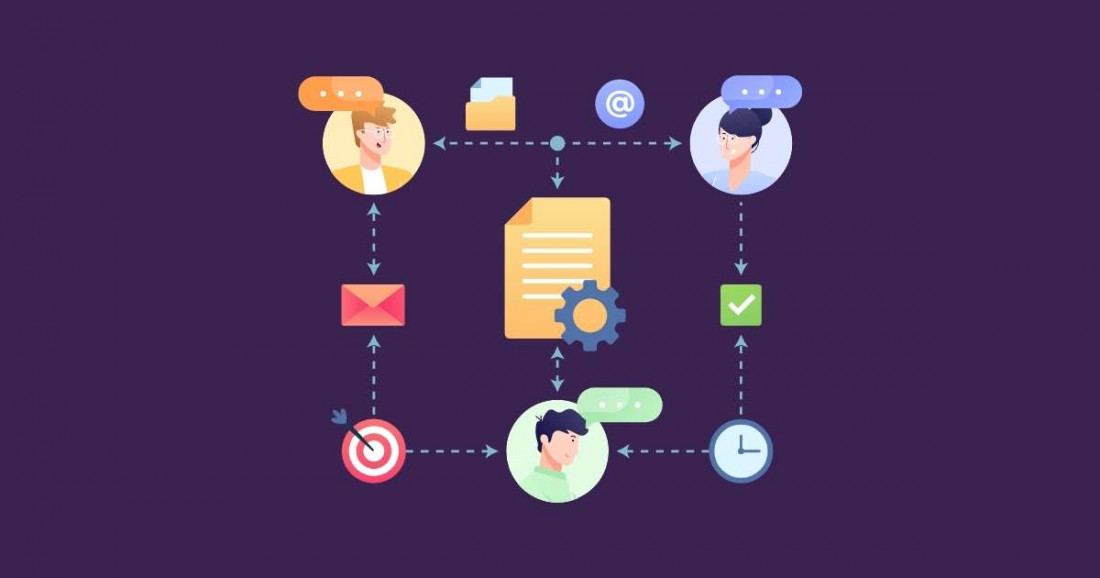Not all paying customers are the same. Some use your product with eager fervor. Others may not really use your product that much. We all want enthusiastic users who firmly recognize the value of your product and make it an integral part of their work. For that, you want user activation.
Today, let's focus on this important part of your user onboarding strategy. We'll walk you through what it is, how to measure it, how to improve it, and how storytelling can help you create personalized activation flows and keep your users around for the long haul.
What is user activation?
User activation refers to the moment when your new users complete the set of initial onboarding steps for the first time. It involves a series of steps, specific events, or predefined milestones your users need to complete to be considered activated.
This may include signing up, setting up a profile, and completing the first task successfully. Or, it can include starting a free trial, completing the onboarding tour, inviting their teammates to collaborate in-product, and getting the whole team on board.
User activation doesn’t apply only to new users, though. For existing customers, activation refers to the moments when they adopt a new feature, unlock a new area of your product by transitioning from a free trial to a paid subscription, or when they move from a basic to a premium plan.
All in all, growing a base of active users who interact with your product on a daily, weekly, or monthly basis is one of the key goals of every SaaS business, as it directly impacts product adoption and retention rates.
Therefore, the user activation rate is one of the key SaaS metrics you need to track. We’ll explain below how to measure this rate and how to increase it, but first, let’s go through some of the fundamental flows closely tied to user activation.
How do you activate a user?
To activate a user, you need to get their attention first (e.g. with targeted marketing campaigns), and then motivate them to get into your product (e.g. by optimizing your website for conversions). Once they sign up, the activation process can start.
From the moment someone becomes a user, the activation continues on different levels and throughout different stages of their journey.
The typical first level of user activation flow goes like this:
A prospective user visits your website >> signs up for the product >> creates a profile >> starts a trial >> completes the first set of tasks >> reaches the “aha!” moment >> tries out different features >> gets the real value
And then the second level of activation can look like this:
A user moves from a basic to premium account >> discovers the second layer of value >> expands the usage >> keeps coming back regularly >> becomes a product fan
Ideally, each of the transitions will be frictionless. To activate users in such an ideal manner, you need to offer a product that solves the right problems for your customers, remove friction and unnecessary steps from the onboarding process, and offer a personalized experience along the way.
Create a personalized activation flow for better results
The best way to track activation results is by creating a personalized experience for each of your ideal customer profiles, a.k.a. user personas, and their specific user journeys. This is where user journey maps can come in handy. Mapping out the activation flow for different personas and their journeys will later help with segmentation and targeting during the activation process.
But, before you jump into the mapping process, make sure you have clearly classified user personas, based on their overall profile, firmographics, relevant processes, and psychographics.
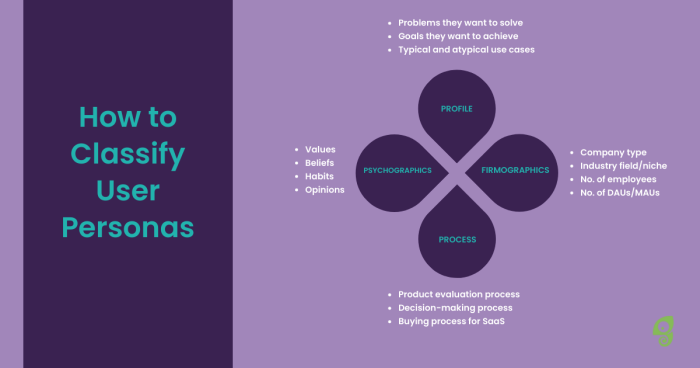
When you have your personas, it’s time to go deeper into visualizing user journeys. For this purpose, you can borrow a storyboarding technique from moviemakers and animators to create a narrative for each activation scenario.
Storyboards outline the events frame-by-frame, so they can be quite useful to keep track of users’ thoughts, expectations, challenges, frustrations, and needs during each activity. After all, that’s how Brian Chesky, CEO of Airbnb, figured out the next steps for Airbnb’s growth back in 2012. Okay, he did hire Pixar’s animator Nick Sung to help him out, but, nevertheless, you don’t need a storyboard masterpiece.
Here’s an example of what a simple activation flow storyboard can look like.
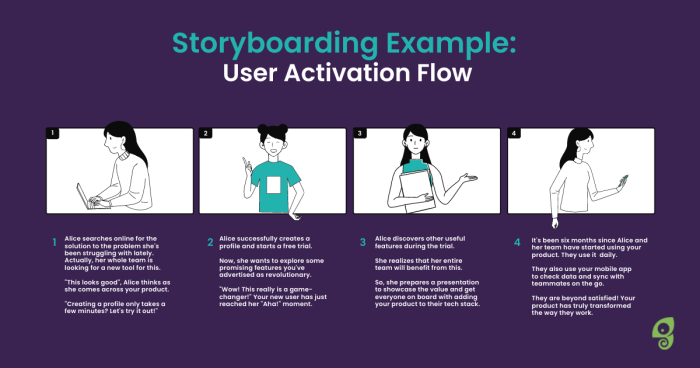
Note: Simply having users sign up, start a trial, or pay for a premium subscription doesn’t mean that they are activated. If you want activated users, they have to complete the activation milestones and get the real value (not only perceive it). In other words, users are activated when they actually get their jobs done using your product.
So, how do you measure user activation?
To measure the activation results, set the milestones your users need to complete to be considered activated. A user activation milestone can be any event that signals a user’s intent to come back, continue using the product, and, eventually, become a paying customer.
The activation rate
The activation rate is the key metric and key indicator of how successful your activation flow is. It shows the percentage of users who successfully complete a predefined milestone or set of steps within the activation process, whether it’s the onboarding flow for new users, advanced feature activation for existing users, trial-to-paid transition flow, or anything else. Here’s an activation rate formula to help you out.

Other relevant metrics
To have a holistic view of the in-product behavior, aside from user activation rates, make sure to also track the following metrics.
Acquisition rate: The number of new signups. As you’ve seen in the formula above, the activation rate is measured against the overall number of users who signed up. To make it easier to track movements, measure the activation and acquisition within a specific period of time. Then, compare data with previous periods.
Time to Value: The amount of time that passes between the initial interaction with your product and the “aha!” moment for your users. But keep in mind that reaching the “aha!” moment still doesn’t mean activation. It represents the understanding of the value, while activation happens after your users get value from your product for a specific use case.
DAUs, WAUs, MAUs: The number of daily active users (DAUs), weekly active users (WAUs), and monthly active users (MAUs). These numbers will vary depending on your product type. For example, if you run a meditation app, you can expect more daily users, but if your product offers machine learning automation for a specific industry, you might see more activities on a monthly basis.
Adoption rate: The percentage of users who have adopted your product or a feature and started using it regularly within a set period of time. The adoption typically refers to a period between user activation and user retention.
Retention rate: The percentage of recurring users who have been actively using your product month-over-month (for monthly plans) or year-over-year (for annual plans). Monthly recurring revenue (MRR) and annual recurring revenue (ARR) are also good indicators of retention.
Churn rate: The number of users who have dropped off at any given point on their user journey. This includes non-activated accounts, trial cancellations, and customers who have canceled their subscription – from free accounts to enterprise-level customers, and anything in between.
Use a product analytics tool like Mixpanel or Amplitude to track these metrics, cross-reference them, and compare them with activation rate to identify problematic issues throughout the activation flow. For example, you can compare acquisition and activation rates, DAUs/MAUs and activation, or activation and retention. Use the insights to shape the activation strategy and identify opportunities for improvement. Then, experiment with different tactics to improve activation.
Make an activation strategy to set clear goals
To avoid aimless testing or ad hoc activation experiments, take your time to set clear, measurable goals for activation flow based on your personas. This will be the foundation of your strategy.
Where to start?
Craig Zingerline, Co-Founder and CEO at Growth University, recommends beginning with a deeper understanding of both your users and your goals.
“You have to understand three things:
1. What is each and every touch point with your user, and what are you doing to both add value and move them to the next stage in the journey? I call this the 'next step activation' goal, and there is usually more than one step.
2. What is the actual end state you are going for with activation? Is it a sign-up? A registration? Free trial? Demo request? Relentlessly focus the steps above on moving to this single goal.
3. What constraints can you use in your activation flow so that you can bump your users against the monetization component of your product naturally. Miro is a great example I use a lot - go sign up for their free plan and see what they do to get you to onboard new team members and bump you up against their free plan constraints.”
– Craig Zingerline, Co-Founder & CEO at Growth University
Once you understand the steps outlined above, it’s time to optimize the strategy and craft an activation model that works best for you.

Try to first improve any gaps in your activation model (i.e. plug those holes first) and then take out the microscope and look for areas of micro-conversion rate optimization. To get the best return on your efforts you probably need to go wide, then deep, and constantly iterate and tune your model.
To learn more about activation strategies and frameworks that can help you grow faster, join Craig Zingerline and industry experts speakers in Mastering Growth, a 5-week training program.
Now, let’s take a look at some effective tactics you can use to iterate and fine-tune activation flow for a better activation rate in the long term.
9 ways to increase activation rate for your product
We’ve gathered best practices, strategies, and tactics for improving user activation processes for new users, increasing the activation rate among existing users, and reactivating inactive users.
Top 3 tactics to improve activation flow for new users
1. Create effective onboarding product tours
Completing the user onboarding process successfully is one of the most important activation milestones. This is the moment of highest motivation for new and trial users – they are eager to get their hands on your product – but also the moment of their highest expectations.
So, when we say effective onboarding tours, we mean tours that are clear, concise, and not overwhelming. Instead of creating a 10-step tour that will point to obvious steps and demotivate users, make a tour that will show users where exactly to focus their efforts next to quickly discover the value.
This is where your journey maps and storyboards can help, so the onboarding tours you create match the journey your users are on.
Hint: you can use Chameleon to craft personalized, on-brand product tours without engaging your dev team.
2. Use onboarding checklists for an interactive flow
To make your activation flow even more attractive for new users, you can break down the onboarding process into several steps and offer a checklist, so that users can easily keep track of the tasks.
For example, you can create an interactive slide-out with several specific tours for different activation stages, or you can use the checklist to add links to your help docs, knowledge hub, and customer support. Make sure that users can easily close and reopen the checklist so that it isn’t blocking them from playing around with your product.
Make sure to check out Chameleon Launchers – we developed them exactly for this purpose. Use them to motivate your users, guide them through the completion of key setup tasks, and increase user activation rate.
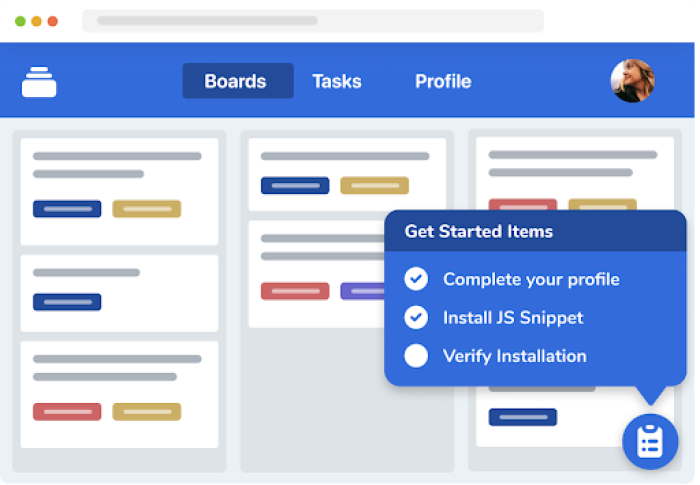
3. Ask for feedback early on
It’s never too early to ask users for their feedback. It signifies that you care about their opinion, and it can make your new users even more invested in trying out your product and diving deeper to discover more value.
To increase the activation rate at this point, you can set up a one-question Microsurvey or emoji-based customer satisfaction Microsurvey to be shown after completing the milestones.
You can simply ask “How easy was this?” or “How would you rate your experience so far?” to get contextual feedback. Aside from getting more actively involved users, you will also collect valuable answers for your future product development iterations.
Top 3 tactics to increase activation rate among existing users
As Jane Portman, Co-Founder of Userlist and podcast host at UI Breakfast and Better Done Than Perfect, outlined in her recent Twitter thread about email marketing automation challenges for SaaS companies, there’s so much confusion around when and how to use email automation.
It’s a 70-part thread, worthwhile reading through, and here are only some of Jane's notes.
“Very few SaaS companies nurture their marketing leads with evergreen campaigns. Very few SaaS companies go beyond a simple welcome sequence and send true behavior-based emails to their customers. Very few SaaS companies go beyond user onboarding and create additional lifecycle touchpoints. There's no industry standard on what user data to track, or how to do it properly. There's no industry standard on how to segment your users and companies.”
– Jane Portman, Co-Founder of Userlist
We reached out to Jane to hear her thoughts on the role of email automation within a user activation flow.

Email automation is the backbone of your user activation. It organizes all your ideas and materials in one orchestrated process and uses the most effective channel—email—to deliver it. We recommend listing all available assets first, and then figuring out the best time to offer them to your users. Even simple time-based campaigns can be effective for user onboarding. But if you send smarter emails based on user behavior, email automation can bring extremely high leverage. It's like customer success that runs on autopilot while you sleep.
Using email automation wisely, based on in-product behaviors, is certainly one of the best tactics to activate users. To succeed with this tactic, craft email sequences based on a specific flow for a specific journey, and for a specific persona.
2. Write compelling release notes and product updates
It’s important to continuously inform your users about all the changes you’ve made, new features you’ve launched, or new development directions you might want to take.
To inform, but not overwhelm, your active users and reach inactive customers, combine several channels for release notes. Send out regular customer emails with product updates, keep your changelog easily accessible on your website, run social media campaigns to announce major changes, and offer in-product tours for new product versions and updates.
To make your release notes more compelling, avoid technical jargon whenever you can. Instead, explain the changes in simple terms, and make sure to explain the benefits users will gain from the updates you’ve made. Aside from that, offer self-serve support to enable users to explore new features at their own pace. This will directly impact your overall product success.
3. Leverage in-app feature announcements
Aside from email campaigns and release notes, use in-app notifications to announce new features. This way, you’ll capture the attention of your user while they are already in the context of using your product.
After the announcement, keep track of the new feature activation rate to evaluate its impact, especially if there’s typically a larger portion of users who use basic features regularly, but rarely (or never) engage with new and advanced features. For a better overview of how this could look like, here’s an example of a New Feature dashboard template from Geckoboard.
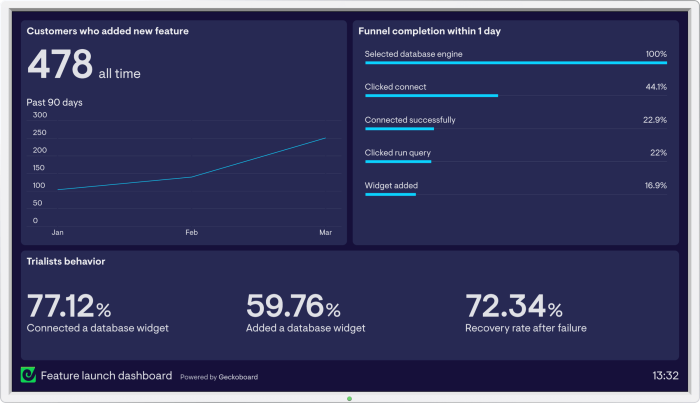
(Source)
Top 3 tactics to reactivate users who haven’t been active in a while
1. Use product analytics to identify inactive users
Dive into product analytics to track in-product behaviors and identify inactive users. This will help you determine when and where to reach out to those who haven’t been active for a while, and how to win them back.
This is also a good tactic to find breaking points in your activation flows. Keep an eye out for the drop-offs between the sign-ups and onboarding tour completion, or between trial and paid conversions. If there’s a significant disproportion, you might need to go back to the drawing board to fix the activation flow and win more active users that way.
2. Start an email campaign for reactivation
Depending on the number of inactive users, this could include custom emails sent out directly to the customers who haven’t been active for some time, or an automated email sequence to try to re-engage users and bring them back.
The exact period will be determined based on your typical product usage. If you typically have a large amount of daily active users, you may reach out after one month of inactivity. If your product is relying on monthly active users, you might reach out to them after six months, or one year of inactivity.
Let’s take Google as an example here. In November 2020 Google announced that starting from June 1, 2021, they would delete the accounts (and all the existing content within those accounts) that haven’t been active for two years in Gmail, Drive, and/or Photos. They also announced that they will inform inactive users several times before they delete their accounts.
But, instead of simply removing inactive accounts from your product, try to re-engage them with a thoughtful email campaign and encourage them to re-discover the value of your product.
Here is an example of how Avocode did it with the “Was Avocode too slow for you?” email campaign.
(Source)
3. Make an offer your users can’t refuse
For users who haven’t been active in their free account, you can start a retargeting campaign based on their previous behavior. For example, this may be a campaign advertising the freemium model you just introduced which opens up a ton of new opportunities that your inactive users can get value from, but they weren’t aware of it.
For users who haven’t been active within the paid plans and they are at risk to churn, you could create a LinkedIn campaign, for example, to showcase the new features you launched, the interface redesign that makes your product even easier to use, or the new subscription plans that better match their needs.
Either way, do your research to find opportunities for growth, whether through an upsell, cross-sell, or a free offer that will clearly showcase the (new) benefits to your inactive users.
Final thoughts: The impact of user activation on product growth
User activation is only one part of an overall product funnel, but it’s one of the most significant elements of product growth.
Once your users become active, make sure to keep them engaged throughout the onboarding process with effective product tours and in-app notifications. For the best results, create a personalized experience for each user persona and their specific activation flow. Keep tracking the movements further down the product funnel and iterate for improvement. A solid base of active users plays a major role in the success, as it directly impacts adoption and retention.
Remember, activation has a few levels, stages, and layers, but the goal is always the same – encourage users to dive in, get involved, and get value from your product.
For more insights on product experimentation, watch our webinar to learn how to discover quick wins inside your product and run smart experiments to meet your users where they are. Then go on and start building new experiences for your users with Chameleon.
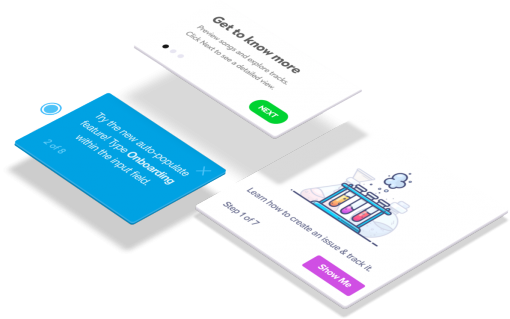
Show users the right content, at the right time
Use Chameleon's product tours, slide-outs, and modals to show users engaging content throughout their journey

